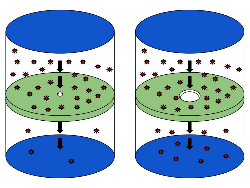Effusion

Effusion is the process in which a gas escapes through a hole of diameter considerably smaller than the mean free path of the molecules.[1] Under these conditions, essentially all molecules which arrive at the hole continue and pass through the hole, since collisions between molecules in the region of the hole are negligible.
By the kinetic theory of gases, the kinetic energy for a gas at a temperature ,
where is the root-mean-square speed of the molecules and is the Boltzmann constant. The average molecular speed is about 0.921 vrms. The rate at which a gas of molar mass M effuses (typically expressed as the number of molecules passing through the hole per second) is then[2]
- ,
Here p is the gas pressure, A is the area of the hole, NA is Avogadro's number, R is the gas constant and T is the absolute temperature.
At a given pressure and temperature, the effusion rate is proportional to the root-mean-square speed and inversely proportional to the square root of the molecular weight. Gases with a lower molecular weight effuse more rapidly than gases with a higher molecular weight, so that the number of lighter molecules passing through the hole per unit time is greater. This is why a balloon filled with low molecular weight helium (M = 4) deflates faster than an equivalent balloon full of higher molecular weight oxygen (M = 32). However the total mass of the escaping molecules is directly proportional to the square root of the molecular weight and is less for lighter molecules.
Graham's law
Scottish chemist Thomas Graham (1805–1869) found experimentally that the rate of effusion of a gas is inversely proportional to the square root of the mass of its particles.[3] In other words, the relative rates of effusion of two gases at the same temperature and pressure are given by the inverse ratio of the square roots of the masses of the gas particles. The equation is given by
where and represent the molar masses of the gases. This equation is known as Graham's law of effusion.
The effusion rate for a gas depends directly on the average velocity of its particles. Thus, the faster the gas particles are moving, the more likely they are to pass through the effusion orifice. A figure of Graham's law of effusion linked below shows the rate of effusion (the rate at which the gas is transferred across the barrier through the pin hole) is inversely proportional to the square root of the mass of the gas molecules.[4]
Knudsen effusion cell
The Knudsen effusion cell is used to measure the vapor pressures of a solid with very low vapor pressure. Such a solid forms a vapor at low pressure by sublimation. The vapor slowly effuses through the pinhole, and the loss of mass is proportional to the vapor pressure and can be used to determine this pressure.[2] The heat of sublimation can also be determined by measuring the vapor pressure as a function of temperature, using the Clausius–Clapeyron relation.[5]
References
- ↑ K.J. Laidler and J.H. Meiser, Physical Chemistry, Benjamin/Cummings 1982, p.18. ISBN 0-8053-5682-7
- 1 2 Peter Atkins and Julio de Paula, Physical Chemistry (8th ed., W.H.Freeman 2006) p.756 ISBN 0-7167-8759-8
- ↑ Zumdahl, Steven S. (2008). Chemical Principles. Boston: Houghton Mifflin Harcourt Publishing Company. p. 164. ISBN 978-0-547-19626-8.
- ↑ Effusion of a gas into an evacuated chamber
- ↑ Drago, R.S. Physical Methods in Chemistry (W.B.Saunders 1977) p.563 ISBN 0-7216-3184-3